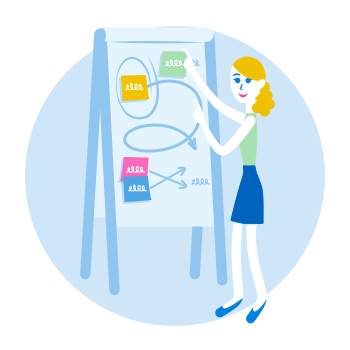Synthesize

The end result of all user research should be actionable learnings that make your product better. Your research should help create insights that you, and your team, can react to and use to push your work forward.
Who's involved:
- UX Designer, Product Manger
Timeline:
- 30mins (Individually) 60mins (w/ your team)
Output:
- Final direction to ship or new hypothesis/revised problem statement to be tested next week
Step-by-step
1) Gather feedback in one place
After your testing, take time to bring all the pieces of information you collected from your research
- Do an audit of the tools you've used to record your feedback (Trello, Evernote, Invision comments, notebook scribbles, Video recordings etc.)
- Gather all your feedback from multiple sessions in one place. Evernote is a great tool for this!
- For info read: How MailChimp uses Evernote to gather research data
2) Summarize each interview and Identify key insights
- Take 2mins at the end of each session to write a short summary of what you've learned.
- Tag items with labels - #UsabilityIssue #Need #Painpoint #Quote #Idea #Suggestion #Important #Request #Positive #Negative #Other - What does this look like?
- Collect highlights/snippets to support what you’re learned (Direct quotes are great!)
- Create a summary of findings that's easily consumable, shareable, and accessible to everyone - your team, your tribe, and the rest of the ORG
3) Regroup and share your learnings in Design circle
Your tribe is often your most valuable asset.
- Sharing your learnings can help both you and your team assess what the next steps might be and how we might be able to best solve them.
- By reviewing results together we are able to settle outstanding assumptions and make a collectively informed decision on how to proceed with a given solution.
4) Plan out your next steps
Sometimes a single UX cycle will uncover that what you're testing might need to be broken down into small pieces.
- Discuss with your team if things may need to be broken down into smaller pieces for further testing.
- Summarize the group's feedback and confirms direction necessary to ship or revise problem statement or hypothesis
- Do we need to test this problem again next week? or are we ready to ship it?
5) Rinse & Repeat
- Research is a part of a lean process.
- Research is about learning, not being right.
Remember:
- User research is a reality check
- Don't be afraid of being wrong
- Research is about learning, not being right!
Tips:
- Collect all your findings in one central place
- Re-read your notes and pull out the points that you feel are most important
- Pull out stories, not opinions
- Uncover the values, not the direct customer needs
- Try to break down your learnings into small bites
Avoid:
- Keeping your research to yourself - make it shareable and accessible to others in the Org
